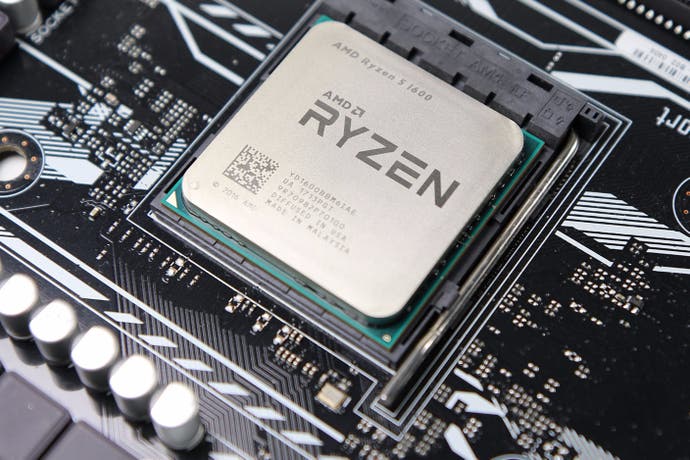AMD Ryzen 5 1600/1600X vs Core i5 7600K review
AMD hits the sweetspot - Ryzen is the better buy.
Since the release of the Core i5 2500K in January 2011, Intel's mainstream quad-core processor line has been the default choice for those looking to put together a capable gaming PC. The i5 is always fast out of the box and overclocking can keep your platform competitive for anything up to five or even six years. But the return of AMD has already proven disruptive in other areas of the x86 market and the Ryzen 5 1600 and 1600X are simply irresistible products: Core i5 is no longer the 'go to' CPU line for gamers - there is now genuine, potent competition. And to cut straight to the chase, given the choice between a 7600K or the cheaper Ryzen 5 1600, it's the AMD product we'd choose.
To understand why Ryzen 5 is so effective, check out this stock vs 4.8GHz overclock Core i5 7600K vs Core i7 7700K benchmark head-to-head. Across the titles tested, the majority show a stock i7 outperforming an overclocked i5. Single-core performance is still important but the takeaway is that more processing cores and threads trump frequency, with the majority of modern game engines favouring more than four cores. The rest of the review effectively writes itself then: what Ryzen 5 lacks in clocks, it makes up for with many more threads. Both Ryzen 5 1600 and 1600X have six full cores and 12 threads, available for the same ballpark money as the i5's basic four cores and four threads.
However, despite Ryzen 5's massive advantage in terms of basic resources, Intel still has some fundamental advantages - but certainly in terms of productivity, there's no competition. Cinebench confirms that Intel's Kaby Lake has a substantial single-thread advantage but on the multi-core benchmark, AMD's lead is overwhelming. The cheaper Ryzen 5 1600 can even beat the Core i7 7700K - even though the latter has a 1GHz advantage over the AMD offering. The extent to which that synthetic benchmark reflects on real-life performance in productivity apps will, of course, vary according to the application.
Here at Digital Foundry, we do a lot of video encoding. The benchmarks a little further down the page are based on our real-life workflow based on 4K processing with Handbrake, using the industry-leading x264 and x265 encoders. They reveal that AMD's much cheaper CPUs can power through h.264 encoding, beating the i5 effortlessly and marginally outperforming the 7700K. However, the HEVC results place the Ryzens in-between the i5 and i7 - this is because the x265 encoder utilises AVX instructions heavily, an area of CPU design where Intel is much stronger.
| Ryzen 5 1600 | Ryzen 5 1600X | Ryzen 7 1700 | Core i5 7600K | Core i7 7700K | |
|---|---|---|---|---|---|
| Cores/Threads | 6/12 | 6/12 | 8/16 | 4/4 | 4/8 |
| Base/Boost Clocks | 3.2GHz/ 3.6GHz | 3.6GHz/ 4.0GHz | 3.0GHz/ 3.7GHz | 3.8GHz/ 4.2GHz | 4.2GHz/ 4.5GHz |
| Cache | 16MB | 16MB | 16MB | 6MB | 8MB |
| TDP | 65W | 95W | 65W | 91W | 91W |
| Supplied Cooler | Wraith Spire | None | Wraith Spire | None | None |
| Price | $214/£189 | $249/£228 | $299/£285 | $242/£222 | $350/£317 |
| Buy from Amazon | AMD Ryzen 5 1600 | AMD Ryzen 5 1600X | AMD Ryzen 7 1700 | Intel Core i5 7600K | Intel Core i7 7700K |
Regardless though, the i5 is clearly on shaky ground. Its per-core performance is excellent, but clearly the lack of hyper-threading is holding it back significantly, both in games (as seen in the i5 vs i7 benchmark video) and productivity applications. Meanwhile, AMD blitzes the competition through sheer brute force in terms of processing resources. It's a strategy that works well in these benchmarks and it also carries through to gaming - which begs the question: to what extent is the CPU important to gameplay?
The role of the CPU is in running game logic and simulation (physics, animation and much more) then preparing the instructions for the GPU on what to draw. Ideally, gaming frame-rates should be limited either by the GPU, by v-sync or by a frame-rate limiter - all of these scenarios give smoother gameplay. Our methodology adjusts the focus though: we run our test titles at 1080p on ultra settings or close to it, and we pair the CPU with an overclocked Titan X Pascal graphics card. The idea is to remove graphics as the limiting factor and push CPU (and by extension, DDR4 memory bandwidth) to the forefront of testing. It's not indicative of performance in an actual gaming rig, but it shows the difference in relative power between one CPU and the next. By extension, you can assume that the CPU with higher results offers more headroom, more future-proofing if you like.
In terms of equipment, we tested our Ryzen 5s on an MSI X370 Titanium board and paired them with two 8GB modules of 3200MHz GSkill Flare-X DDR4. A key advantage of the AM4 platform is that processor and memory overclocking is not limited to the most expensive boards though - we also verified similar results in an Asus board based on the cheaper B350 chipset. For Intel, to get the best out of the unlocked K chips, investing in either a Z170 or Z270 board is essential - overclocking only works with those expensive chipsets, and even your fast DDR4 is limited to 2400MHz on lower-end motherboards. Hopefully, this kind of artificial limitation will be phased out in future now that Intel doesn't have the market to itself.
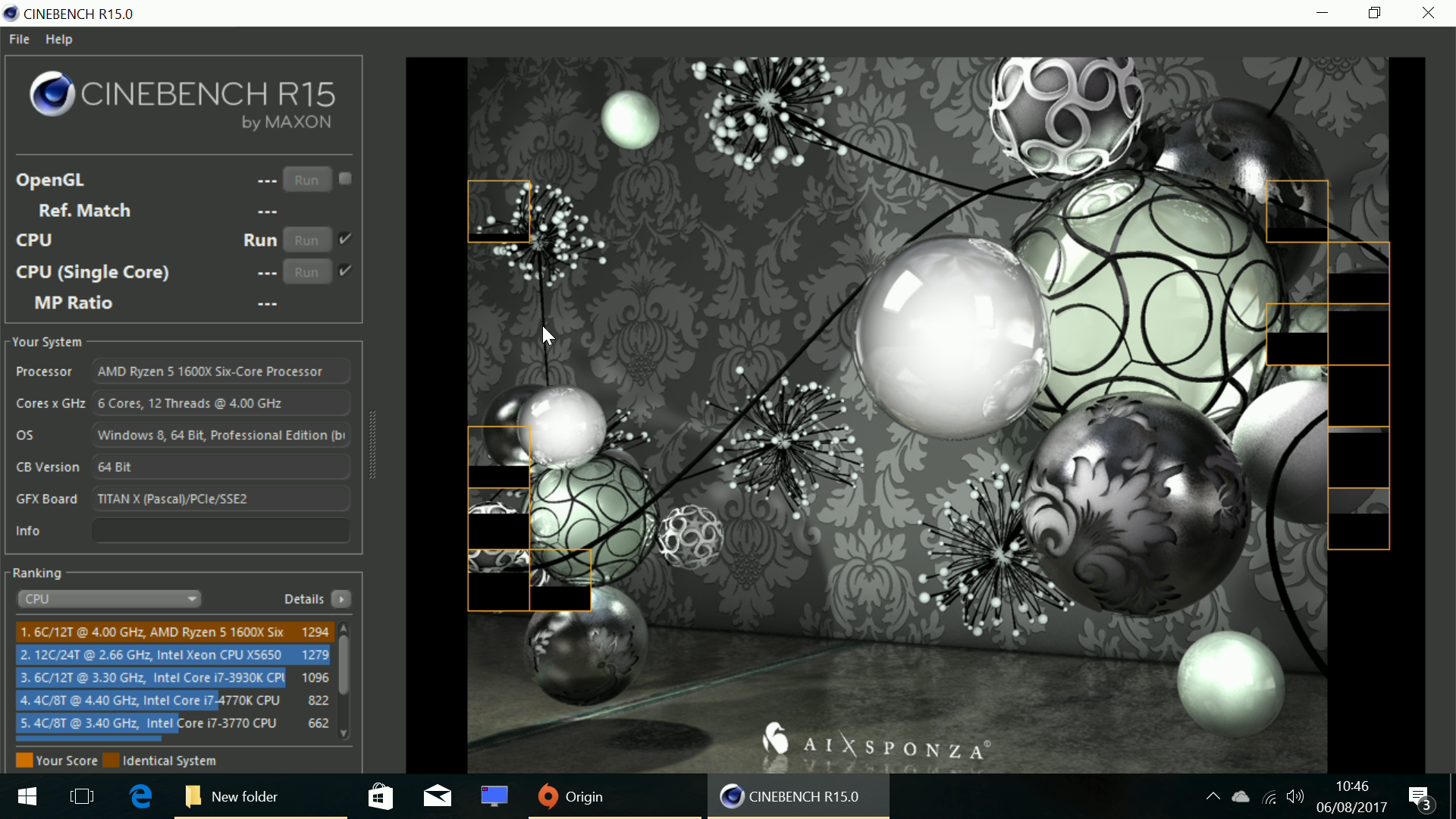
| Ryzen 5 1600 | Ryzen 5 1600X | Ryzen 7 1700 | Core i5 7600K | Core i7 7700K | |
|---|---|---|---|---|---|
| CineBench R15 Single Core | 141 | 155 | 153 | 173 | 187 |
| CineBench R15 Multi-Core | 1137 | 1207 | 1390 | 654 | 963 |
| Handbrake h.264 | 19.7fps | 20.1fps | 22.4fps | 13.8fps | 19.3fps |
| Handbrake HEVC | 5.3fps | 5.5fps | 5.9fps | 4.4fps | 6.3fps |
As we've already established, modern game engines tend to favour many-core designs, but if there's one stand-out example in our test suite of a more old-school reliance on single-thread performance, it's the Far Cry engine. Additional frequency translates into higher frame-rates, explaining why both six-core Ryzen 5s outperform the entry-level eight-core Ryzen 7, and also why the i5 and i7 are so far ahead of the AMD competition. An interesting side-note on Far Cry Primal can be seen here, where we compare a 3.2GHz Skylake i5 6500 to the Ryzen 5s - it takes the Ryzen 5 1600X at 3.6GHz to match the Intel chip running 400MHz slower. Meanwhile, the Ryzen 5 1600 represents the same workload running clock-for-clock between R5 and i5 though we do have a small memory bandwidth advantage on the AMD side.
Elsewhere, however, the race tightens up. The Witcher 3, Rise of the Tomb Raider and especially Crysis 3 love frequency of course, but they also benefit heavily from as many cores and threads as you can throw at them, with both Ryzen 5s offering a significant advantage over Intel's stock Core i5. Here, Ryzen 5 sits comfortably at a mid-point between Core i5 and Core i7. However, not everything is as it seems based on the numbers alone. Assassin's Creed Unity posts a lead on the i5, but when studying performance at the per-scene level, i5 is pulling ahead in relatively empty scenes in our benchmark, with Ryzen 5 performing better in areas packed with NPCs. There's the suggestion that the i5 frame-rate average is boosted by big performance gains in less useful, more 'empty' rendering scenes. Similarly, in the Crysis 3 benchmark, the i5 and indeed i7's scores are skewed higher when the viewpoint shifts to similarly sparse scenes.
We've got a complete breakdown of this behaviour in our video review, but the bottom line is that it's not just different game engines that can favour i5 or Ryzen 5 processors - it can actually vary on a scene-by-scene nature in many games. And of course, therefore, results can vary depending very much on what scenes are chosen for benchmarking.
To illustrate, The Witcher 3's Novigrad City - our test area - can easily max an i5 quad with 100 per cent utilisation across all cores, and Ryzen 5 is faster here. However, benchmark a less demanding area or an engine-driven cut-scene and the i5 takes the lead. We've tried to tailor our tests to concentrate more on these heavier workloads and for our money Ryzen 5 is the more versatile, capable performer in areas where the CPU matters most in gaming.
The balance of power shifts when it comes to the more expensive Core i7 7700K - despite losing two cores up against the Ryzen 5s, enabling hyper-threading sees it power ahead in most of our tests, and even though Crysis 3 in particular makes such good use of AMD's many-core design, the 7700K is the only processor in the test suite here that will keep you above 60fps at all times. It's an excellent product, but you pay a hefty premium for that top-tier consistency in performance. But what about overclocking? It got somewhat toasty and required a heavy duty cooler, but we could push both Kaby Lake Core i5 and i7 processors to 4.8GHz - to what extent does that push the i7 further into the lead, and can i5 claw back into contention against Ryzen 5?
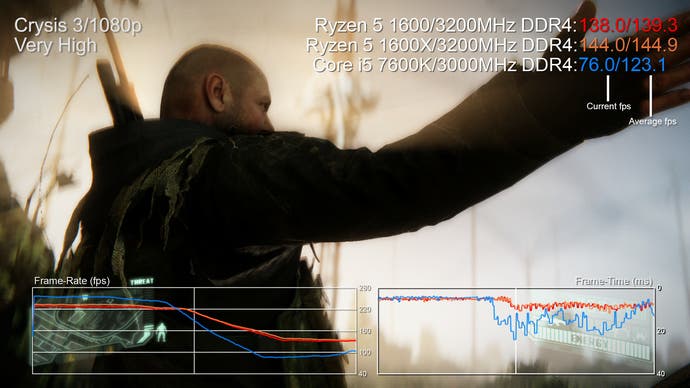
| 1080p/Titan X OC | Ryzen 5 1600 | Ryzen 5 1600X | Ryzen 7 1700 | Core i5 7600K | Core i7 7700K |
|---|---|---|---|---|---|
| Assassin's Creed Unity, Ultra High | 116.4 | 118.7 | 114.8 | 121.4 | 132.2 |
| Crysis 3, Very High | 124.9 | 130.9 | 126.7 | 99.4 | 138.2 |
| The Division, Ultra | 129.8 | 130.9 | 129.8 | 132.0 | 133.8 |
| Far Cry Primal, Ultra | 91.8 | 96.1 | 84.7 | 117.2 | 137.9 |
| Rise of the Tomb Raider DX12, Very High | 95.6 | 99.8 | 95.2 | 89.7 | 126.5 |
| The Witcher 3, Ultra, No Hairworks | 106.1 | 111.6 | 109.3 | 97.7 | 139.4 |
For our overclocking tests, we push each processor to their limits and in the case of Ryzen, the eight-core 1700 running at 4.0GHz effectively represents the very best gaming performance you can expect from any of the new AMD CPUs running on the AM4 socket (even the top-tier 1800X overclocks to much the same limit). Our 1600X hit the same 4.0GHz overclock and the remarkable reality is that despite losing a couple of cores against the Ryzen 7 processors, very little performance is lost. However, in all of our tests with Ryzen at 4.0GHz, we've found that voltage requirements - and thus heat generation - require substantial cooling solutions. Curiously, even under a closed-loop liquid cooler, our Ryzen 5 1600 maxed at 'just' 3.8GHz, but here's the thing: you can achieve the same frequency using the supplied Wraith Spire heatsink and fan you get for free with the processor.
For a mainstream system, this is crucial. The Ryzen 5 1600 is not only cheaper than the 1600X, you save further money in that you don't need to purchase a cooler. And it's the same situation with the Intel chips - only the locked, non-K chips come with coolers, and they're flimsy affairs that aren't built for overclocking. The Wraith Spire with the Ryzen 5 1600 is a meaty piece of kit, definitely delivering good performance in this sense, making it by far the most best value offering out of the whole bunch of processors we're testing here. The bump to frame-rates in moving from 3.2GHz to 3.8GHz is incremental, but it raises those crucial minimum frame-rates and delivers the psychological victory that you're outperforming the more expensive 1600X. The fact that it's achievable without shelling out for a better thermal solution only adds to the feel-good factor.
On the face of it, adding in the region of six to eight per cent to performance via a CPU overclock seems like an irrelevance, but what it translates to in day-to-day gaming is more consistent performance under load and for most players - using standard 60Hz screens - that translates to a better lock on 60fps gameplay. The one exception to the more modest gains found when overclocking comes (predictably) from the single-thread focused Far Cry Primal, which achieves an 18 per cent uplift on the i5. Generally though, the idea that the i5 can be overclocked to match Ryzen 5's prodigious multi-core gaming performance isn't totally validated by our results. The takeaway is that overclocking helps Intel more than it does AMD, but looking at the benchmarks on a scene-by-scene basis, even a 4.8GHz core speed doesn't massively help the complex scenes that the i5 struggled with at stock speeds. More cores really can make a big difference.
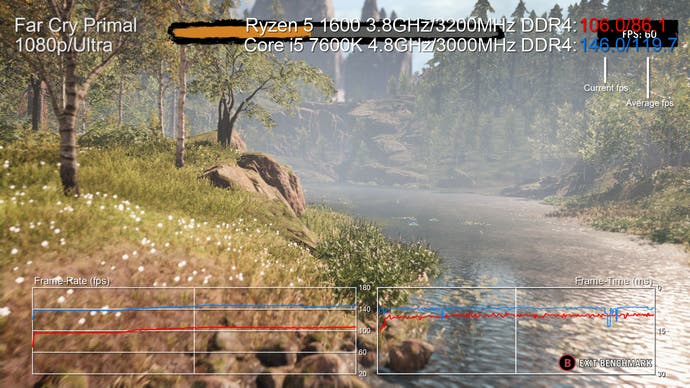
| 1080p/Titan X OC | Ryzen 5 1600 3.8GHz | Ryzen 5 1600X 4.0GHz | Ryzen 7 1700 4.0GHz | Core i5 7600K 4.8GHz | Core i7 7700K 4.8GHz |
|---|---|---|---|---|---|
| Assassin's Creed Unity, Ultra High | 118.9 | 119.8 | 120.2 | 125.4 | 132.9 |
| Crysis 3, Very High | 132.7 | 134.3 | 142.3 | 108.6 | 145.5 |
| The Division, Ultra | 129.6 | 130.9 | 130.5 | 134.6 | 133.9 |
| Far Cry Primal, Ultra | 98.7 | 100.9 | 96.9?? | 137.4 | 140.1 |
| Rise of the Tomb Raider DX12, Very High | 100.7 | 100.2 | 104.5 | 97.8 | 131.0 |
| The Witcher 3, Ultra, No Hairworks | 112.5 | 115.6 | 120.0 | 114.9 | 145.2 |
Of course, the more expensive i7 blazes into the distance on many titles and wins across the board. However, up against the maxed out eight-core Ryzen 7, one result bears explanation: Crysis 3 on Ryzen 7 at 4.0GHz clearly copes better with the more complex areas of the benchmark scene than the 7700K at 4.8GHz, holding frame-rate better on those packed vista shots. The i7, meanwhile, skews its results upwards with stratospheric frame-rates in less complex scene - we're not entirely sure this properly represents relative gameplay performance between the two chips. However, even with overclocking in place across the board on our test processors, the i7 is still the only CPU that keeps Crysis 3 running north of 60fps. At the conclusion of the test sequence, Crysis 3 streams in new level data while processing that intense vista shot - surprisingly, this combination of heavy workloads causes momentary stutter that favours Intel. The eight-core overclocked Ryzen dips to 56fps, the 7700K bottoms out at 73fps.
Our methodology in testing CPU performance in games is good for ascertaining relative performance in identical workloads, but the truth is, CPUs like the Ryzen 5 and the Core i5 lines aren't likely to be paired with an overclocked Titan in day-to-day gameplay. They are far more likely to be combined with graphics hardware that introduces a hard limit to gaming performance - GeForce GTX 1060 and Radeon RX 580, for example. We kept our processor overclocks in place and played a handful of demanding titles with both the Ryzen 5 1600 and the Core i5 7600K paired with the Nvidia card. The end result? The Witcher 5 actually runs ever-so-slightly faster on the i5, though the difference is borderline negligible and both CPUs can easily deliver a locked 60fps. Far Cry Primal - the bane of AMD in CPU benchmarks - runs identically on both i5 and Ryzen 5 with the GTX 1060 in place.
Crysis 3 is a different story, though. In its Welcome to the Jungle stage, this title ping-pongs between CPU and GPU limits and clearly the Ryzen 5 1600 has the bettering of the Intel chip, with anything between a 10-15fps lead in CPU-bound gameplay. As we mentioned in our Skylake-X review, despite being over four years old now, Crysis 3 on its very high setting remains a highly taxing game and it still severely challenges i5-class hardware, whichever generation you own, regardless of how high you clock it, however fast your DDR4 memory, whatever GPU you choose to use in your set-up. Only the 7700K steered north of 60fps at all times in this demanding title, but in the mid-range processor category, Ryzen 5 emerges triumphant here. And remember - in this test, the i5 is running with a 1GHz advantage under a closed loop liquid cooling solution. The AMD chip was operating with its supplied stock cooler.
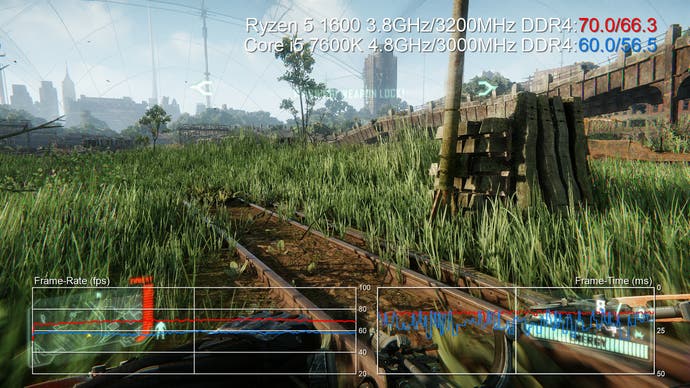
The takeaway from both our relative performance and 'real life' 1080p60 gaming tests is pretty straightforward. Core i5 remains a hugely potent CPU for gaming, just as it always has been. However, even with a GTX 1060, you can hit CPU-bound scenarios during gameplay and since the move to the current console generation, the majority of game-makers have built their engines around many-core designs. This translates to the PC space and it seems to be paying off here with Ryzen 5.
Ryzen 5 vs Core i5: the Digital Foundry verdict
There are now two great gaming CPU lines available for the core gamer. The overwhelming weight of the data points to Ryzen 5 as the best buy in this market segment, specifically the non-X 1600 model. It's especially compelling against the only two locked i5 chips we'd consider for gaming: the locked Core i5 7500 and 7600. Although it's a touch more expensive, you can overclock any Ryzen chip and you can run them with faster memory, 'luxuries' that are only permitted with the more expensive 7600K and top-tier Intel motherboards. And for its part, the once unassailable unlocked i5 K chip - beloved of gamers for so long - is overwhelmed in more complex gaming workloads by the wider Ryzen 5 six-core processors, while non-gaming tasks see the full weight of those extra cores and threads put to good use.
The bad news for AMD - if you can call it that - is that the 1600X is looking rather superfluous based on just how good the base 1600 is. Even at stock speeds, the performance differential isn't massive, and the 1600 overclocks well enough to beat stock 1600X performance. Our 1600 sample may not overclock to 4.0GHz like the 1600X does, but with a solid 3.8GHz on the supplied cooler (which you don't get with the X), we're happy to trade the 200MHz deficit in performance for the money we save. The only sticking point is that that some of those savings you make on your Ryzen system should be invested into faster RAM, with the aim being to hit circa 3000MHz or higher. It's a point made in many Ryzen articles, but to be fair, as our Core i5 7600K review demonstrates, fast RAM is a must for getting the most out of an Intel chip too.
Remarkably, Ryzen 5's performance overall is so good, it even makes an eight-core Ryzen 7 purchase look questionable if gaming is your focus - there's a very curious lack of scalability between six and eight cores based on the 1600X vs 1700 4.0GHz overclock results in the table above and there's even a scenario (Far Cry, of course) where six cores at 4.0GHz offers a slightly faster result than eight at the same frequency. Ryzen 5 offering so much here is actually a double-edged sword: it's good in the short term because you're getting excellent performance for your money, but it relies on significant improvements in later revisions of the Zen core to offer a tangible upgrade path if and when you feel the need to improve CPU performance.
This is less of an issue for Intel. Core i5 upgrades to i7 of course, offering a big chunk of extra overhead, but with the news that eighth-gen Core processors won't run on existing Z170 or Z270 motherboards, a quad-core i7 is as far as you can go. That's fair enough, except we're days/weeks away from Intel confirming its own mainstream six-core i5s and i7s. How those new 'Coffee Lake' Intel processors are going to shake out in terms of value is anyone's guess right now, but certainly based on the performance of the enthusiast Core i7 7800, a keenly-priced six-core chip would restore the balance of power in Intel's favour.
But with the CPUs available to buy right now, Ryzen 5 1600 is our choice as the best mainstream gaming CPU on the market. And that's a simply phenomenal achievement - since the debut of the Core i5 2500K back in 2011, Intel's i5 K chips have earned their place at the heart of millions of users' gaming PCs. The Ryzen alternative is faster where it needs to be, better suited to more modern game engines, and comes across overall as a kind of hybrid of i5 and four-core/six-core i7s depending on how its resources are deployed. This is AMD at its best: innovative, disruptive and bringing about radical change in a static market, with a simply superb alternative product.
